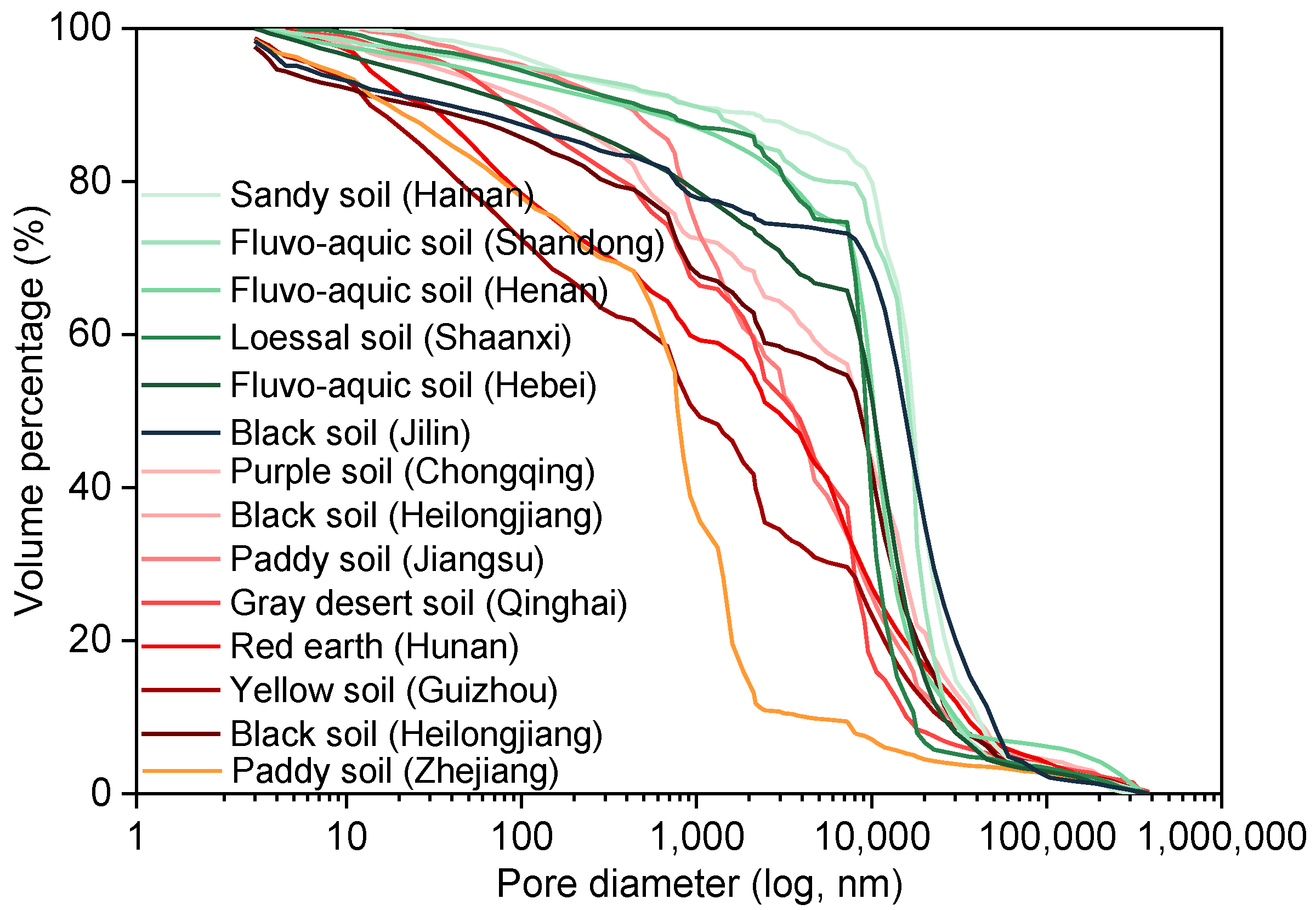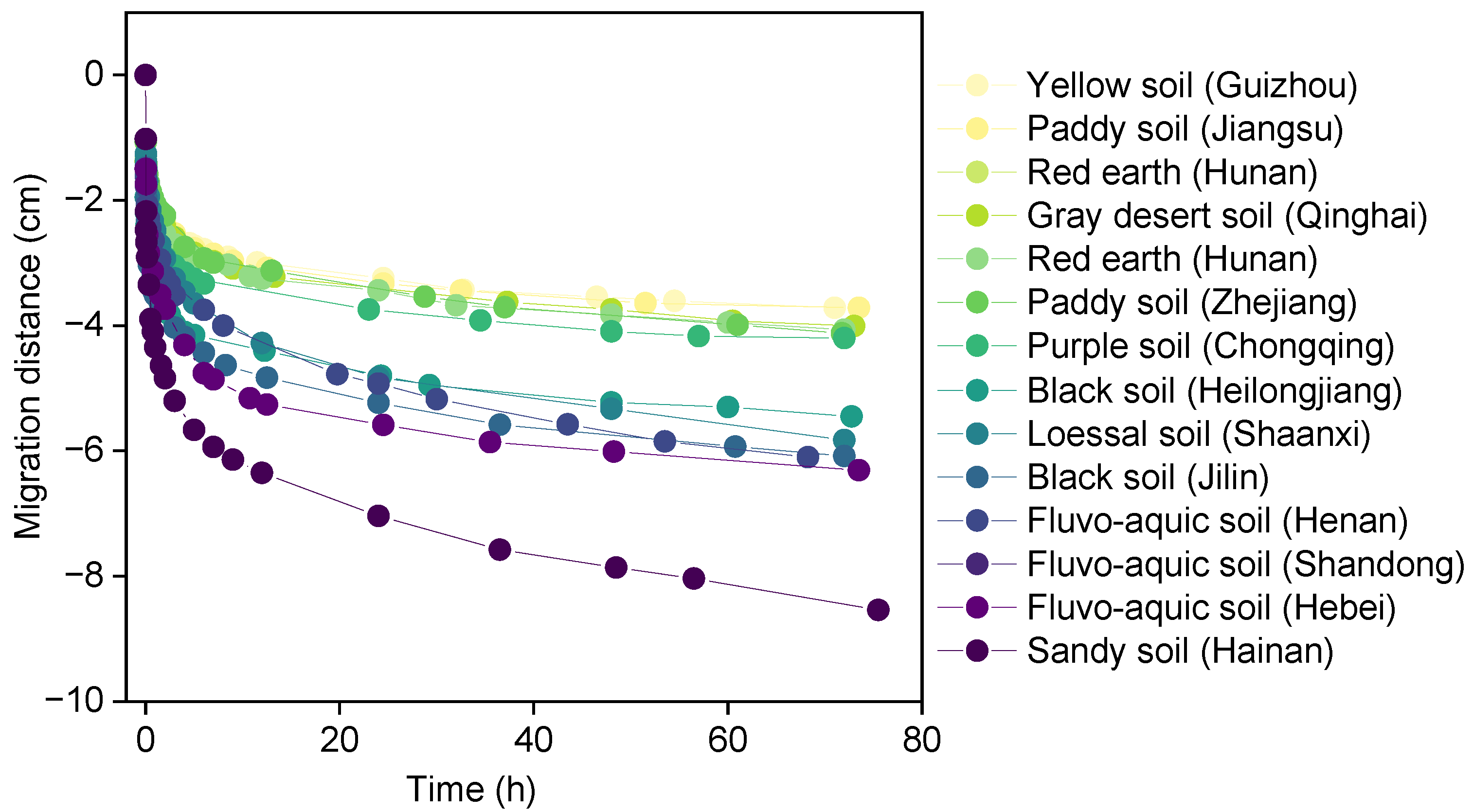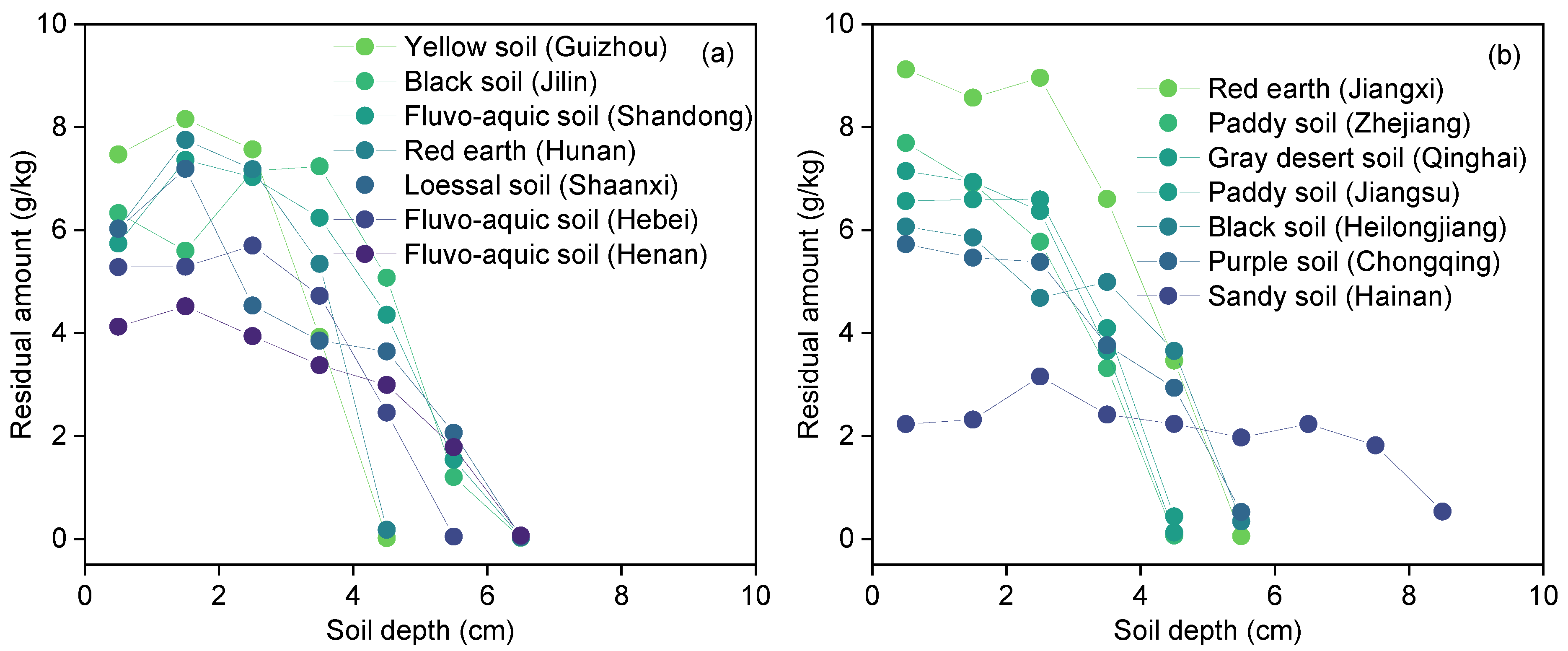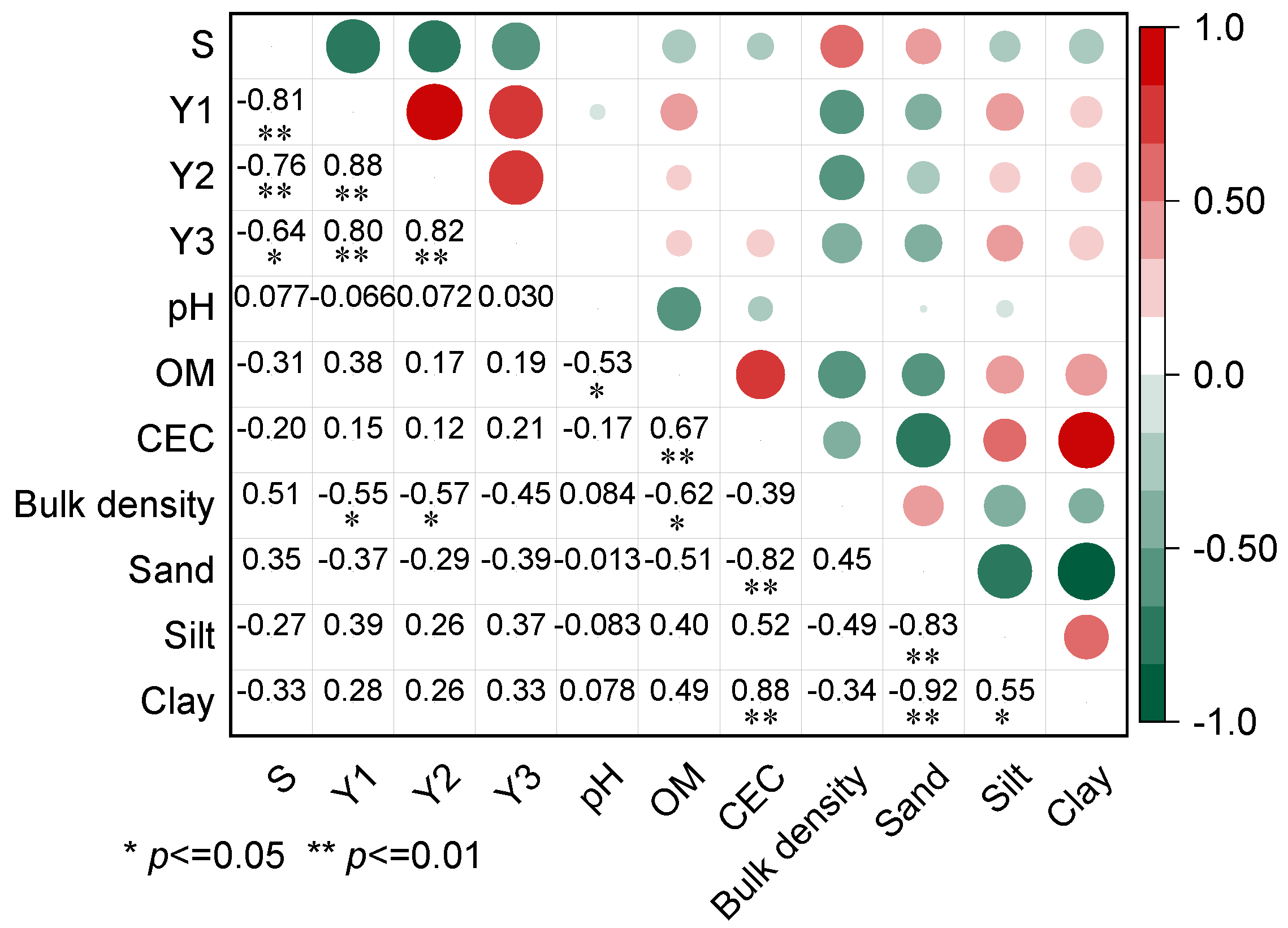Novel Insights into the Influence of Soil Microstructure Characteristics on the Migration and Residue of Light Non-Aqueous Phase Liquid
Abstract
:1. Introduction
2. Materials and Methods
2.1. Soil Samples
2.2. Experimental Device
2.3. Experimental Procedures
2.4. Analytical Methods
3. Results and Discussion
3.1. Basic Physiochemical Properties and Structure Characteristics of Soils
3.1.1. Basic Physiochemical Properties of Soils
3.1.2. Characteristic Parameters of Soil Particle Size Distribution
+ 0.1023Z8 + 0.1017Z9 − 0.0662Z10 + 0.0939Z11 + 0.0777Z12
− 0.0133Z8 − 0.0129Z9 + 0.0612Z10 + 0.5167Z11 + 0.4945Z12
3.1.3. Characteristic Parameters of Soil Pore Size Distribution
3.2. Migration Distance of Diesel in Fourteen Types of Soils
3.3. Residual Amount of Diesel in Fourteen Types of Soils
3.4. Statistical Analysis of Soil Characteristics Affecting Diesel Migration and Residue
3.4.1. Effect of Basic Physiochemical Properties of Soil
3.4.2. Effect of Soil Particle Size Distribution
3.4.3. Effect of Soil Pore Size Distribution
4. Conclusions
Supplementary Materials
Author Contributions
Funding
Institutional Review Board Statement
Informed Consent Statement
Data Availability Statement
Acknowledgments
Conflicts of Interest
References
- Kaimi, E.; Mukaidani, T.; Miyoshi, S.; Tamaki, M. Ryegrass enhancement of biodegradation in diesel-contaminated soil. Environ. Exp. Bot. 2006, 55, 110–119. [Google Scholar] [CrossRef]
- Gupta, D.; Sarker, B.; Thadikaran, K.; John, V.; Maldarelli, C.; John, G. Sacrificial amphiphiles: Eco-friendly chemical herders as oil spill mitigation chemicals. Sci. Adv. 2015, 1, e1400265. [Google Scholar] [CrossRef] [PubMed] [Green Version]
- Erofeevskya, L.A.; Aleksandrov, A.R. Liquidation of oil and petroleum products spills based on use of NA and CA-differences of zeolite. IOP Conf. Ser. Earth Environ. Sci. 2020, 459, 052011. [Google Scholar] [CrossRef]
- Wang, S.; Wang, D.; Yu, Z.C.; Dong, X.G.; Liu, S.M.; Cui, H.M.; Sun, B. Advance in research on petroleum biodegradability in soil. Environ. Sci. Proc. Imp. 2020, 23, 9–27. [Google Scholar] [CrossRef]
- Lari, K.S.; Rayner, J.L.; Davis, G.B. Towards optimizing LNAPL remediation. Water Resour. Res. 2019, 55, 923–936. [Google Scholar] [CrossRef]
- Garg, S.; Newell, C.J.; Kulkarni, P.R.; King, D.C.; Adamson, D.T.; Renno, M.I.; Sale, T. Overview of natural source zone depletion: Processes, controlling factors, and composition change. Ground Water Monit. Remediat. 2017, 37, 62–81. [Google Scholar] [CrossRef] [Green Version]
- Luo, L.; Zhang, S.Z.; Ma, Y.B. Evaluation of impacts of soil fractions on phenanthrene sorption. Chemosphere 2008, 72, 891–896. [Google Scholar] [CrossRef]
- Yoon, H.; Werth, C.J.; Valocchi, A.J.; Oostrom, M. Impact of nonaqueous phase liquid (NAPL) source zone architecture on mass removal mechanisms in strongly layered heterogeneous porous media during soil vapor extraction. J. Contam. Hydrol. 2008, 100, 58–71. [Google Scholar] [CrossRef]
- Chen, B.L.; Huang, W.H. Effects of compositional heterogeneity and nanoporosity of raw and treated biomass-generated soot on adsorption and absorption of organic contaminants. Environ. Pollut. 2011, 159, 550–556. [Google Scholar] [CrossRef]
- Su, K.N.; Rahman, N.A.; Bob, M.M. Observation of light non-aqueous phase liquid migration in aggregated soil using image analysis. Transp. Porous Med. 2012, 92, 83–100. [Google Scholar]
- Rahman, N.A.; Foong, L.K.; Nazir, R.; Lewis, R.W. Vibration effect influence upon non-aqueous phase liquid migration in double-porosity soil. Geol. Croat. 2018, 71, 163–171. [Google Scholar] [CrossRef]
- Liang, Y.T.; Nostrand, J.D.V.; Deng, Y.; He, Z.L.; Wu, L.Y.; Zhang, X.; Li, G.H.; Zhou, J.Z. Functional gene diversity of soil microbial communities from five oil-contaminated fields in China. ISME J. 2011, 5, 403–413. [Google Scholar] [CrossRef] [PubMed] [Green Version]
- Liang, Y.T.; Zhang, X.; Wang, J.; Li, G.H. Spatial variations of hydrocarbon contamination and soil properties in oil exploring fields across China. J. Hazard. Mater. 2012, 241–242, 371–378. [Google Scholar] [CrossRef]
- Tang, S.; She, D.; Wang, H. Effect of salinity on soil structure and soil hydraulic characteristics. Can. J. Soil Sci. 2021, 101, 62–73. [Google Scholar] [CrossRef]
- Sasal, M.C.; Andriulo, A.E.; Taboada, M.A. Soil porosity characteristics and water movement under zero tillage in silty soils in Argentinian Pampas. Soil. Tillage Res. 2006, 87, 9–18. [Google Scholar] [CrossRef]
- Saripalli, K.P.; Rao, P.; Annable, M. Determination of specific NAPL–water interfacial areas of residual NAPLs in porous media using the interfacial tracers technique. J. Contam. Hydrol. 1998, 30, 375–391. [Google Scholar] [CrossRef]
- Arshadi, M.; Gesho, M.; Qin, T.; Goual, L.; Piri, M. Impact of mineralogy and wettability on pore-scale displacement of NAPLs in heterogeneous porous media. J. Contam. Hydrol. 2020, 230, 103599. [Google Scholar] [CrossRef]
- Liao, S.C.; Saleeba, Z.; Bryant, J.D.; Abriola, L.M.; Pennell, K.D. Influence of aqueous film forming foams on the solubility and mobilization of non-aqueous phase liquid contaminants in quartz sands. Water Res. 2021, 195, 116975. [Google Scholar] [CrossRef]
- Montero, E. Rényi dimensions analysis of soil particle-size distributions. Ecol. Model. 2005, 182, 305–315. [Google Scholar] [CrossRef]
- Han, C.M.; Zhang, H.; Gu, Q.B.; Guo, G.L.; Li, Y.; Li, F.S. Toluene sorption behavior on soil organic matter and its composition using three typical soils in China. Environ. Earth Sci. 2013, 68, 741–747. [Google Scholar] [CrossRef]
- Alloway, B.J. Heavy Metals in Soils: Trace Metals and Metalloids in Soils and Their Bioavailability, 3rd ed.; Alloway, B.J., Ed.; Blackie Academic and Professional: London, UK, 2013. [Google Scholar]
- Kabata-Pendias, A.; Pendias, H. Trace Elements in Soils and Plants, 3rd ed.; CRC Press: London, UK, 2001. [Google Scholar]
- Golia, E.E.; Tsiropoulos, G.N.; Füleky, G.; Floras, S.; Vleioras, S. Pollution assessment of potentially toxic elements in soils of different taxonomy orders in central Greece. Environ. Monit. Assess. 2019, 191, 106. [Google Scholar] [CrossRef] [PubMed]
- Kim, M.; Kim, K.Y.; Lim, J.H.; Chan, Y.K.; Kim, S.G.; Han, G.; Han, W.S.; Park, E. Pore-scale investigation of dynamic immiscible displacement in layered media using synchrotron X-ray microtomography. Environ. Sci. Technol. 2021, 56, 282–292. [Google Scholar] [CrossRef] [PubMed]
- Lu, R. Analytical Methods of Soil and Agricultural Chemistry; China Agricultural Science and Technology Press: Beijing, China, 1999; pp. 107–240. [Google Scholar]
- Li, X.D.; Wu, B.; Zhang, Q.; Liu, Y.Q.; Wang, J.Q.; Xu, D.P.; Li, F.S.; Ma, F.J.; Gu, Q.B. Effects of soil properties on the remediation of diesel-contaminated soil by Triton X-100-aided washing. Environ. Sci. Pollut. Res. 2020, 27, 23323–23330. [Google Scholar] [CrossRef] [PubMed]
- Giménez, D.; Perfect, E.; Rawls, W.J.; Pachepsky, Y. Fractal models for predicting soil hydraulic properties: A review. Eng. Geol. 1997, 48, 161–183. [Google Scholar] [CrossRef]
- Gan, D.Q.; Yang, X.; Zhang, Y.P. Experimental analysis on permeability characteristics of iron tailings. Math. Probl. Eng. 2019, 2019, 6539846. [Google Scholar] [CrossRef] [Green Version]
- Smedt, F.D.; Wierenga, P.J. Solute transport through soil with nonuniform water content. Soil Sci. Soc. Am. J. 1978, 42, 7–10. [Google Scholar] [CrossRef]
- Shi, X.Z.; Yu, D.S.; Warner, E.D.; Sun, W.X.; Petersen, G.W.; Gong, Z.T.; Lin, H. Cross-reference system for translating between genetic soil classification of china and soil taxonomy. Soil Sci. Soc. Am. J. 2005, 70, 78–83. [Google Scholar] [CrossRef] [Green Version]
- Xia, J.; Ren, R.; Chen, Y. Multifractal characteristics of soil particle distribution under different vegetation types in the Yellow River Delta chenier of China. Geoderma 2020, 368, 114311. [Google Scholar] [CrossRef]
- Shamkhi, M.S.; Albadry, H.J. Soil texture distribution for east wasit province, Iraq. IOP Conf. Ser. Earth Environ. Sci. 2022, 961, 012073. [Google Scholar] [CrossRef]
- Wang, H.J.; Liu, Q.H.; Shi, X.Z.; Yu, D.S.; Zhao, Y.C. Carbon storage and spatial distribution patterns of paddy soils in China. Front. Agric. China 2007, 1, 149–154. [Google Scholar] [CrossRef]
- Lima, R.; Rolim, M.M.; Toledo, M.; Tormena, C.A.; Silva, A.; Silva, I.; Pedrosa, E. Texture and degree of compactness effect on the pore size distribution in weathered tropical soils. Soil Till. Res. 2022, 215, 105215. [Google Scholar] [CrossRef]
- Ren, W.G.; Zhou, H.W.; Zhong, J.C.; Xue, D.J.; Wang, C.S.; Liu, Z.L. A multi-scale fractal approach for coal permeability estimation via MIP and NMR methods. Energies 2022, 15, 2807. [Google Scholar] [CrossRef]
- Wang, B.Y.; Liu, B.; Sun, G.X.; Bai, L.H.; Chi, Y.; Liu, Q.; Liu, M. Evaluation of the shale oil reservoir and the oil enrichment model for the first member of the lucaogou formation, western jimusaer depression, junggar basin, NW China. ACS Omega 2021, 6, 12081–12098. [Google Scholar] [CrossRef] [PubMed]
- Ryzhik, V. Spreading of a NAPL lens in a double-porosity medium. Computat. Geosci. 2007, 11, 1–8. [Google Scholar] [CrossRef]
- Wang, Y.Q.; Shao, M.A. Infiltration characteristics of non-aqueous phase liquids in undisturbed loessal soil cores. J. Environ. Sci. 2009, 21, 1424–1431. [Google Scholar] [CrossRef]
- Li, Y.X.; Zheng, X.L.; Ma, Y.F. Experimental study on the infiltration of diesel through unsaturated zone of soil. Environ. Pollut. Control. 2011, 33, 27–31. [Google Scholar]
- Zhang, L.; Zhang, L.Z.; Xu, Z.M.; Guo, X.Y.; Xu, C.M.; Zhao, S.Q. Viscosity mixing rule and viscosity-temperature relationship estimation for oil sand bitumen vacuum residue and fractions. Energy Fuels 2019, 33, 206–214. [Google Scholar] [CrossRef]
- Simantiraki, F.; Aivalioti, M.; Gidarakos, E. Implementation of an image analysis technique to determine LNAPL infiltration and distribution in unsaturated porous media. Desalination 2009, 248, 705–715. [Google Scholar] [CrossRef]
- Kim, P.G.; Tarafdar, A.; Kwon, J.H. Effects of soil pH on the sorption capacity of soil organic matter for polycyclic aromatic hydrocarbons in unsaturated soils. Pedosphere 2022, in press. [Google Scholar] [CrossRef]
- Potts, J.; Jones, D.L.; Macdonald, A.; Ma, Q.X.; Cross, P. Acetamiprid fate in a sandy loam with contrasting soil organic matter contents: A comparison of the degradation, sorption and leaching of commercial neonicotinoid formulations. Sci. Total Environ. 2022, 842, 156711. [Google Scholar] [CrossRef]
- Kodešová, R.; Vignozzi, N.; Rohošková, M.; Hájková, T.; Kočárek, M.; Pagliai, M.; Kozák, J.; Šimůnek, J. Impact of varying soil structure on transport processes in different diagnostic horizons of three soil types. J. Contam. Hydrol. 2009, 104, 107–125. [Google Scholar] [CrossRef] [PubMed]
- Chen, C.H.; Li, X.L.; Zhang, L.; Ying, Y.; Jiang, L.Q.; Che, S.L. Influence of particle size distribution on the consistency of high permeability MnZn Ferrite. Mater. Sci. Forum 2014, 787, 357–361. [Google Scholar] [CrossRef]
- Zhang, Y.J.; Zhu, S.Q.; Xiao, R.; Wang, J.; Li, F.S. Vertical transport of polycyclic aromatic hydrocarbons in different particle-size fractions of sandy soils. Environ. Geol. 2008, 53, 1165–1172. [Google Scholar] [CrossRef]
- Yang, S.C.; Liu, J.W.; Xu, L.F.; Zhang, M.Y.; Jeng, D.S. A new approach to explore the surface profile of clay soil using white light interferometry. Sensors 2020, 20, 3009. [Google Scholar] [CrossRef]
- Tang, L.; Gudda, F.O.; Wu, C.X.; Ling, W.; El-Ramady, H.; Mosa, A.; Wang, J. Contributions of partition and adsorption to polycyclic aromatic hydrocarbons sorption by fractionated soil at different particle sizes. Chemosphere 2022, 301, 134715. [Google Scholar] [CrossRef] [PubMed]
- Alazaiza, M.Y.D.; Ngien, S.K.; Bob, M.M.; Kamaruddin, S.A.; Ishak, W.M.F. Influence of macro-pores on DNAPL migration in double-porosity soil using light transmission visualization method. Transp. Porous Med. 2017, 117, 103–123. [Google Scholar] [CrossRef]





| Classification (Location) | pH | OM g/kg | CEC cmol/kg | Soil Bulk Density g/cm3 | Sand % | Silt % | Clay % | Soil Texture |
|---|---|---|---|---|---|---|---|---|
| Gray desert soil (Qinghai) | 7.90 | 23.10 | 5.81 | 1.3537 | 73.38 | 7.36 | 19.26 | sandy clay loam soil |
| Yellow soil (Guizhou) | 3.96 | 29.00 | 12.00 | 1.3537 | 82.03 | 2.80 | 15.17 | sandy clay loam soil |
| Loessal soil (Shaanxi) | 8.76 | 1.35 | 2.57 | 1.492 | 79.07 | 4.55 | 16.38 | sandy clay loam soil |
| Fluvo-aquic soil (Hebei) | 7.96 | 11.50 | 12.20 | 1.4669 | 60.47 | 17.02 | 22.51 | sandy clay loam soil |
| Red earth (Jiangxi) | 7.77 | 14.60 | 10.50 | 1.6052 | 63.41 | 13.08 | 23.51 | sandy clay loam soil |
| Paddy soil (Zhejiang) | 5.06 | 23.40 | 9.24 | 1.4040 | 59.99 | 26.62 | 13.39 | clay loamy soil |
| Purple soil (Chongqing) | 7.44 | 8.38 | 18.20 | 1.6219 | 66.69 | 5.65 | 27.66 | clay loamy soil |
| Black soil (Jilin) | 6.88 | 31.30 | 26.00 | 1.2951 | 33.06 | 26.71 | 40.23 | clay loamy soil |
| Black soil (Heilongjiang) | 5.55 | 47.90 | 34.90 | 1.3998 | 40.60 | 16.10 | 43.30 | clay loamy soil |
| Red earth (Hunan) | 7.69 | 7.46 | 21.20 | 1.5423 | 40.81 | 18.19 | 41.00 | clay loamy soil |
| Fluvo-aquic soil (Henan) | 7.98 | 13.60 | 9.35 | 1.5507 | 85.40 | 3.86 | 10.74 | sandy loam soil |
| Fluvo-aquic soil (Shandong) | 7.81 | 11.00 | 14.3 | 1.3789 | 74.84 | 11.76 | 13.40 | sandy loam soil |
| Sandy soil (Hainan) | 5.65 | 3.26 | 1.92 | 1.8734 | 94.30 | 0.80 | 4.90 | sandy soil |
| Paddy soil (Jiangsu) | 7.78 | 20.20 | 15.70 | 1.4878 | 64.34 | 10.33 | 25.33 | sandy clay soil |
| Classification (Location) | Diameter Distance | Consistency | SSA | D[3,2] | D[4,3] | Dv10 | Dv30 | Dv50 | Dv60 | Dv90 | Cc | Cu |
|---|---|---|---|---|---|---|---|---|---|---|---|---|
| m2/g | μm | μm | μm | μm | μm | μm | μm | |||||
| Gray desert soil (Qinghai) | 4.06 | 2.08 | 1.03 | 5.85 | 45.61 | 2.36 | 8.54 | 18.27 | 25.37 | 76.54 | 10.76 | 1.22 |
| Yellow soil (Guizhou) | 4.62 | 1.40 | 2.32 | 2.59 | 9.21 | 0.98 | 2.48 | 4.96 | 6.98 | 23.92 | 7.16 | 0.90 |
| Loessal soil (Shaanxi) | 2.17 | 0.67 | 0.85 | 7.09 | 43.03 | 2.87 | 20.74 | 39.52 | 48.37 | 88.66 | 16.83 | 3.09 |
| Fluvo-aquic soil (Hebei) | 3.66 | 1.17 | 1.15 | 5.22 | 24.27 | 2.03 | 6.05 | 15.74 | 23.48 | 59.54 | 11.60 | 0.77 |
| Red earth (Jiangxi) | 4.73 | 2.54 | 1.67 | 3.60 | 25.65 | 1.36 | 4.09 | 8.66 | 12.31 | 42.37 | 9.06 | 1.00 |
| Paddy soil (Zhejiang) | 15.38 | 3.97 | 1.35 | 4.45 | 54.38 | 1.61 | 5.65 | 12.42 | 18.65 | 192.62 | 11.61 | 1.06 |
| Purple soil (Chongqing) | 5.71 | 1.80 | 1.66 | 3.62 | 19.00 | 1.34 | 3.75 | 8.62 | 12.94 | 50.59 | 9.69 | 0.81 |
| Black soil (Jilin) | 5.95 | 1.97 | 1.53 | 3.92 | 17.58 | 1.55 | 3.71 | 7.90 | 12.49 | 48.56 | 8.04 | 0.71 |
| Black soil (Heilongjiang) | 3.17 | 1.06 | 1.40 | 4.27 | 13.87 | 1.72 | 4.69 | 9.14 | 12.29 | 33.43 | 7.14 | 1.04 |
| Red earth (Hunan) | 5.27 | 1.69 | 1.91 | 3.14 | 12.49 | 1.27 | 3.07 | 5.78 | 8.03 | 31.73 | 6.31 | 0.92 |
| Fluvo-aquic soil (Henan) | 3.03 | 1.00 | 0.99 | 6.09 | 39.25 | 2.24 | 10.84 | 28.76 | 38.16 | 89.23 | 17.06 | 1.38 |
| Fluvo-aquic soil (Shandong) | 4.07 | 1.35 | 1.00 | 6.02 | 35.80 | 2.28 | 7.10 | 21.40 | 37.33 | 89.29 | 16.36 | 0.59 |
| Sandy soil (Hainan) | 2.16 | 0.65 | 0.39 | 15.53 | 303.27 | 10.13 | 160.31 | 281.98 | 342.58 | 619.32 | 33.81 | 7.41 |
| Paddy soil (Jiangsu) | 4.58 | 1.48 | 1.35 | 4.45 | 18.69 | 1.83 | 4.85 | 9.69 | 13.57 | 46.24 | 7.41 | 0.95 |
Disclaimer/Publisher’s Note: The statements, opinions and data contained in all publications are solely those of the individual author(s) and contributor(s) and not of MDPI and/or the editor(s). MDPI and/or the editor(s) disclaim responsibility for any injury to people or property resulting from any ideas, methods, instructions or products referred to in the content. |
© 2022 by the authors. Licensee MDPI, Basel, Switzerland. This article is an open access article distributed under the terms and conditions of the Creative Commons Attribution (CC BY) license (https://creativecommons.org/licenses/by/4.0/).
Share and Cite
Li, X.; Zhang, Q.; Zhang, X.; Shen, J.; Sun, Z.; Ma, F.; Wu, B.; Gu, Q. Novel Insights into the Influence of Soil Microstructure Characteristics on the Migration and Residue of Light Non-Aqueous Phase Liquid. Toxics 2023, 11, 16. https://doi.org/10.3390/toxics11010016
Li X, Zhang Q, Zhang X, Shen J, Sun Z, Ma F, Wu B, Gu Q. Novel Insights into the Influence of Soil Microstructure Characteristics on the Migration and Residue of Light Non-Aqueous Phase Liquid. Toxics. 2023; 11(1):16. https://doi.org/10.3390/toxics11010016
Chicago/Turabian StyleLi, Xiaodong, Qian Zhang, Xueli Zhang, Jialun Shen, Zongquan Sun, Fujun Ma, Bin Wu, and Qingbao Gu. 2023. "Novel Insights into the Influence of Soil Microstructure Characteristics on the Migration and Residue of Light Non-Aqueous Phase Liquid" Toxics 11, no. 1: 16. https://doi.org/10.3390/toxics11010016





